Financial Management Analysis: Statements, Ratios, and Recommendations
VerifiedAdded on 2023/06/13
|12
|2469
|130
Report
AI Summary
This report provides a comprehensive overview of financial management, emphasizing its importance in organizational planning, control, and financial activity direction. It explores key concepts, including financial planning, liquidity management, investment opportunities, and tax planning. The report details the main financial statements—income statement, cash flow statement, and balance sheet—and explains the use of financial ratios for performance analysis, covering profitability, efficiency, and liquidity ratios. It includes a business review template, income statement, balance sheet, and ratio computations with interpretations. Furthermore, the report offers recommendations for improving organizational performance, focusing on strategic plans, expense management, investment strategies, and liquidity optimization, ultimately aiming to maximize shareholder wealth. The document highlights the benefits of analyzing financial statements for stakeholders and concludes that effective financial management is crucial for sustainable business growth. Desklib provides this document as a resource, along with many other solved assignments and past papers.

Importance of
financial management.
financial management.
Paraphrase This Document
Need a fresh take? Get an instant paraphrase of this document with our AI Paraphraser
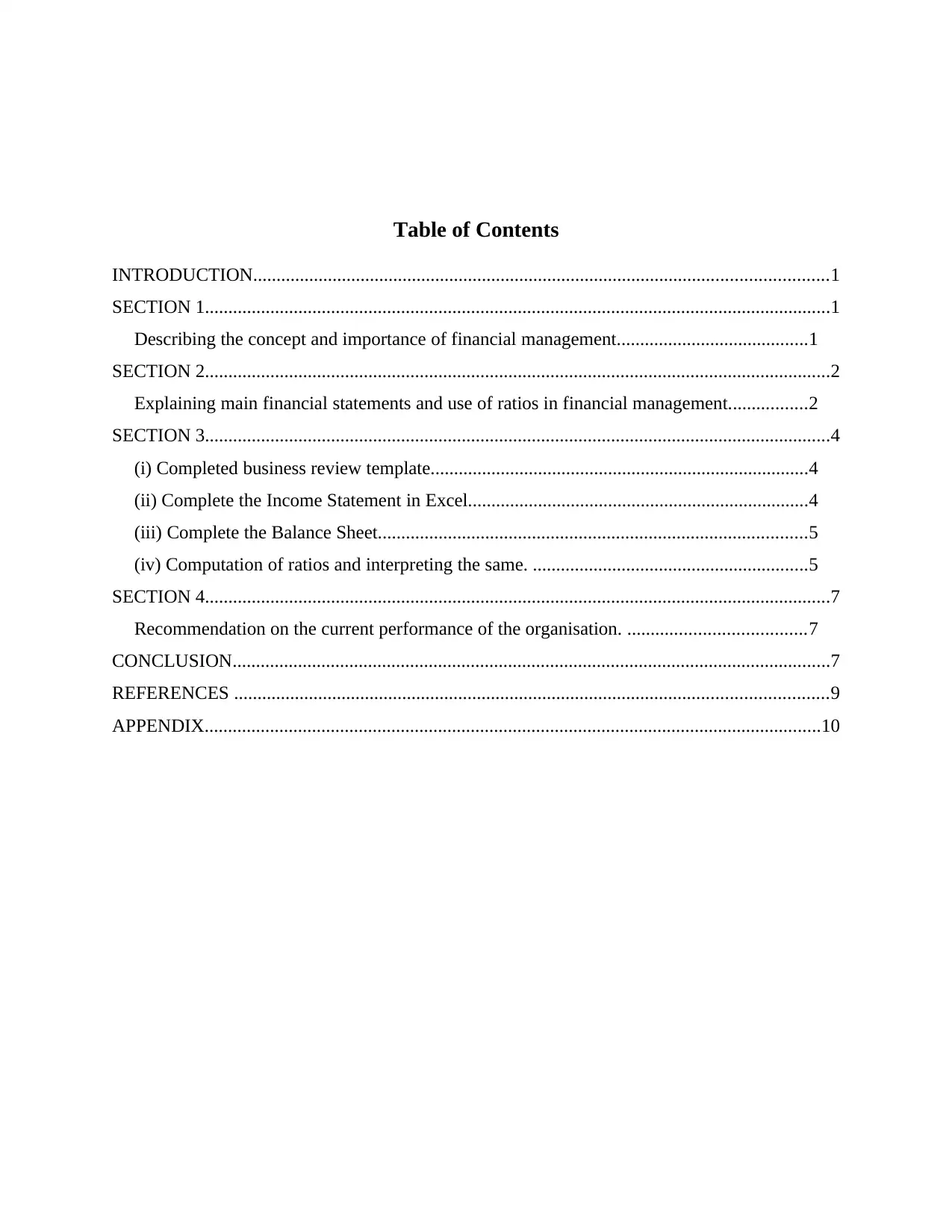
Table of Contents
INTRODUCTION...........................................................................................................................1
SECTION 1......................................................................................................................................1
Describing the concept and importance of financial management.........................................1
SECTION 2......................................................................................................................................2
Explaining main financial statements and use of ratios in financial management.................2
SECTION 3......................................................................................................................................4
(i) Completed business review template.................................................................................4
(ii) Complete the Income Statement in Excel.........................................................................4
(iii) Complete the Balance Sheet............................................................................................5
(iv) Computation of ratios and interpreting the same. ...........................................................5
SECTION 4......................................................................................................................................7
Recommendation on the current performance of the organisation. ......................................7
CONCLUSION................................................................................................................................7
REFERENCES ...............................................................................................................................9
APPENDIX....................................................................................................................................10
INTRODUCTION...........................................................................................................................1
SECTION 1......................................................................................................................................1
Describing the concept and importance of financial management.........................................1
SECTION 2......................................................................................................................................2
Explaining main financial statements and use of ratios in financial management.................2
SECTION 3......................................................................................................................................4
(i) Completed business review template.................................................................................4
(ii) Complete the Income Statement in Excel.........................................................................4
(iii) Complete the Balance Sheet............................................................................................5
(iv) Computation of ratios and interpreting the same. ...........................................................5
SECTION 4......................................................................................................................................7
Recommendation on the current performance of the organisation. ......................................7
CONCLUSION................................................................................................................................7
REFERENCES ...............................................................................................................................9
APPENDIX....................................................................................................................................10
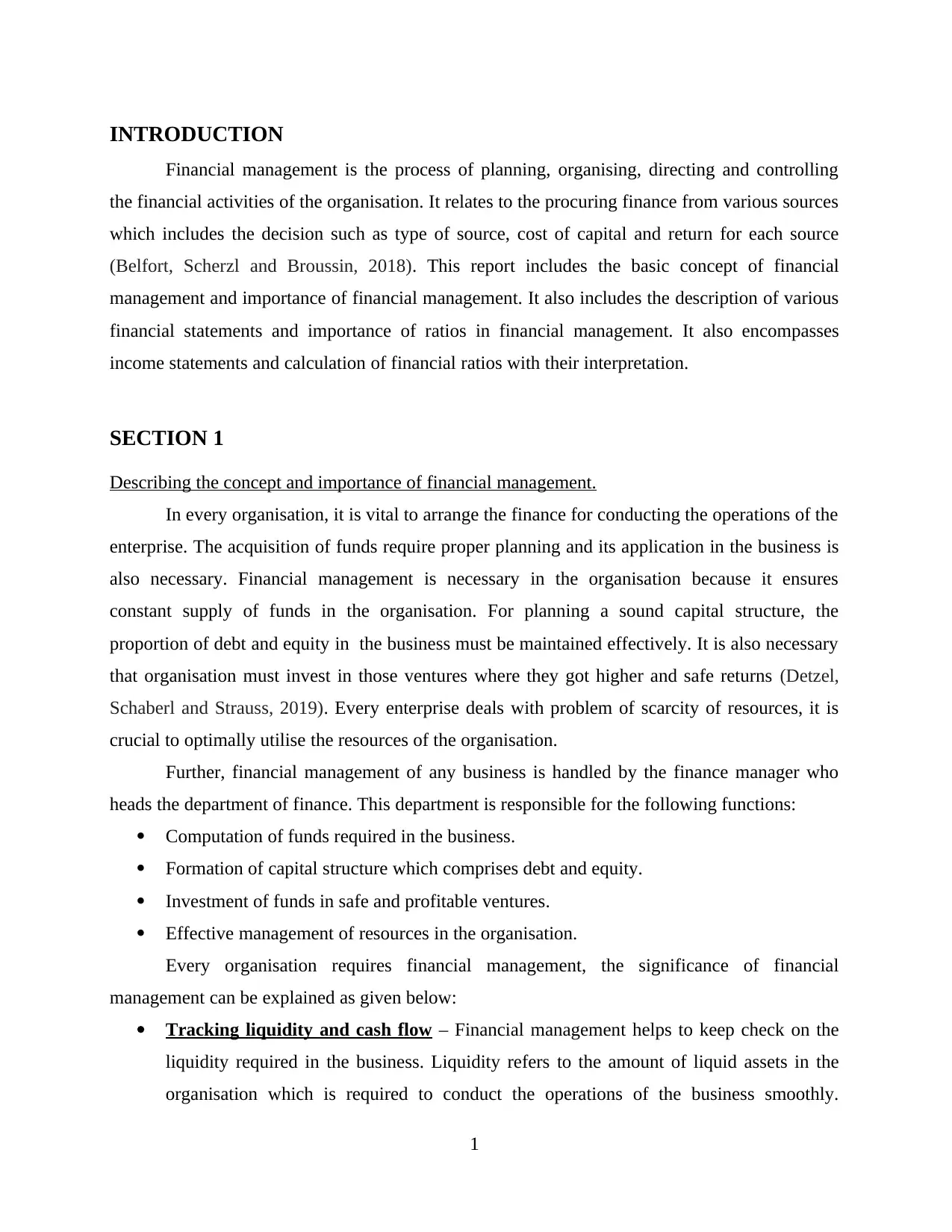
INTRODUCTION
Financial management is the process of planning, organising, directing and controlling
the financial activities of the organisation. It relates to the procuring finance from various sources
which includes the decision such as type of source, cost of capital and return for each source
(Belfort, Scherzl and Broussin, 2018). This report includes the basic concept of financial
management and importance of financial management. It also includes the description of various
financial statements and importance of ratios in financial management. It also encompasses
income statements and calculation of financial ratios with their interpretation.
SECTION 1
Describing the concept and importance of financial management.
In every organisation, it is vital to arrange the finance for conducting the operations of the
enterprise. The acquisition of funds require proper planning and its application in the business is
also necessary. Financial management is necessary in the organisation because it ensures
constant supply of funds in the organisation. For planning a sound capital structure, the
proportion of debt and equity in the business must be maintained effectively. It is also necessary
that organisation must invest in those ventures where they got higher and safe returns (Detzel,
Schaberl and Strauss, 2019). Every enterprise deals with problem of scarcity of resources, it is
crucial to optimally utilise the resources of the organisation.
Further, financial management of any business is handled by the finance manager who
heads the department of finance. This department is responsible for the following functions:
Computation of funds required in the business.
Formation of capital structure which comprises debt and equity.
Investment of funds in safe and profitable ventures.
Effective management of resources in the organisation.
Every organisation requires financial management, the significance of financial
management can be explained as given below:
Tracking liquidity and cash flow – Financial management helps to keep check on the
liquidity required in the business. Liquidity refers to the amount of liquid assets in the
organisation which is required to conduct the operations of the business smoothly.
1
Financial management is the process of planning, organising, directing and controlling
the financial activities of the organisation. It relates to the procuring finance from various sources
which includes the decision such as type of source, cost of capital and return for each source
(Belfort, Scherzl and Broussin, 2018). This report includes the basic concept of financial
management and importance of financial management. It also includes the description of various
financial statements and importance of ratios in financial management. It also encompasses
income statements and calculation of financial ratios with their interpretation.
SECTION 1
Describing the concept and importance of financial management.
In every organisation, it is vital to arrange the finance for conducting the operations of the
enterprise. The acquisition of funds require proper planning and its application in the business is
also necessary. Financial management is necessary in the organisation because it ensures
constant supply of funds in the organisation. For planning a sound capital structure, the
proportion of debt and equity in the business must be maintained effectively. It is also necessary
that organisation must invest in those ventures where they got higher and safe returns (Detzel,
Schaberl and Strauss, 2019). Every enterprise deals with problem of scarcity of resources, it is
crucial to optimally utilise the resources of the organisation.
Further, financial management of any business is handled by the finance manager who
heads the department of finance. This department is responsible for the following functions:
Computation of funds required in the business.
Formation of capital structure which comprises debt and equity.
Investment of funds in safe and profitable ventures.
Effective management of resources in the organisation.
Every organisation requires financial management, the significance of financial
management can be explained as given below:
Tracking liquidity and cash flow – Financial management helps to keep check on the
liquidity required in the business. Liquidity refers to the amount of liquid assets in the
organisation which is required to conduct the operations of the business smoothly.
1
⊘ This is a preview!⊘
Do you want full access?
Subscribe today to unlock all pages.

Trusted by 1+ million students worldwide
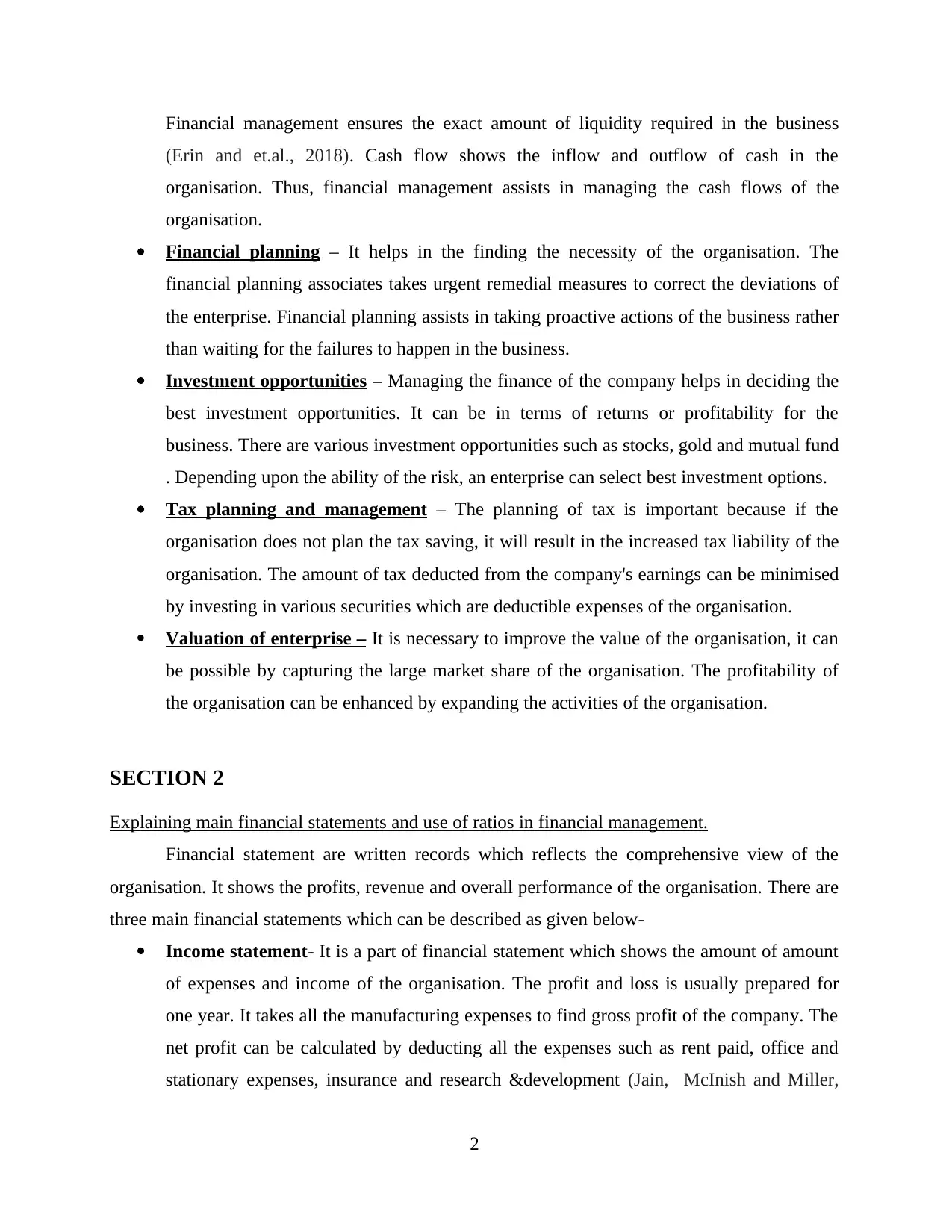
Financial management ensures the exact amount of liquidity required in the business
(Erin and et.al., 2018). Cash flow shows the inflow and outflow of cash in the
organisation. Thus, financial management assists in managing the cash flows of the
organisation.
Financial planning – It helps in the finding the necessity of the organisation. The
financial planning associates takes urgent remedial measures to correct the deviations of
the enterprise. Financial planning assists in taking proactive actions of the business rather
than waiting for the failures to happen in the business.
Investment opportunities – Managing the finance of the company helps in deciding the
best investment opportunities. It can be in terms of returns or profitability for the
business. There are various investment opportunities such as stocks, gold and mutual fund
. Depending upon the ability of the risk, an enterprise can select best investment options.
Tax planning and management – The planning of tax is important because if the
organisation does not plan the tax saving, it will result in the increased tax liability of the
organisation. The amount of tax deducted from the company's earnings can be minimised
by investing in various securities which are deductible expenses of the organisation.
Valuation of enterprise – It is necessary to improve the value of the organisation, it can
be possible by capturing the large market share of the organisation. The profitability of
the organisation can be enhanced by expanding the activities of the organisation.
SECTION 2
Explaining main financial statements and use of ratios in financial management.
Financial statement are written records which reflects the comprehensive view of the
organisation. It shows the profits, revenue and overall performance of the organisation. There are
three main financial statements which can be described as given below-
Income statement- It is a part of financial statement which shows the amount of amount
of expenses and income of the organisation. The profit and loss is usually prepared for
one year. It takes all the manufacturing expenses to find gross profit of the company. The
net profit can be calculated by deducting all the expenses such as rent paid, office and
stationary expenses, insurance and research &development (Jain, McInish and Miller,
2
(Erin and et.al., 2018). Cash flow shows the inflow and outflow of cash in the
organisation. Thus, financial management assists in managing the cash flows of the
organisation.
Financial planning – It helps in the finding the necessity of the organisation. The
financial planning associates takes urgent remedial measures to correct the deviations of
the enterprise. Financial planning assists in taking proactive actions of the business rather
than waiting for the failures to happen in the business.
Investment opportunities – Managing the finance of the company helps in deciding the
best investment opportunities. It can be in terms of returns or profitability for the
business. There are various investment opportunities such as stocks, gold and mutual fund
. Depending upon the ability of the risk, an enterprise can select best investment options.
Tax planning and management – The planning of tax is important because if the
organisation does not plan the tax saving, it will result in the increased tax liability of the
organisation. The amount of tax deducted from the company's earnings can be minimised
by investing in various securities which are deductible expenses of the organisation.
Valuation of enterprise – It is necessary to improve the value of the organisation, it can
be possible by capturing the large market share of the organisation. The profitability of
the organisation can be enhanced by expanding the activities of the organisation.
SECTION 2
Explaining main financial statements and use of ratios in financial management.
Financial statement are written records which reflects the comprehensive view of the
organisation. It shows the profits, revenue and overall performance of the organisation. There are
three main financial statements which can be described as given below-
Income statement- It is a part of financial statement which shows the amount of amount
of expenses and income of the organisation. The profit and loss is usually prepared for
one year. It takes all the manufacturing expenses to find gross profit of the company. The
net profit can be calculated by deducting all the expenses such as rent paid, office and
stationary expenses, insurance and research &development (Jain, McInish and Miller,
2
Paraphrase This Document
Need a fresh take? Get an instant paraphrase of this document with our AI Paraphraser
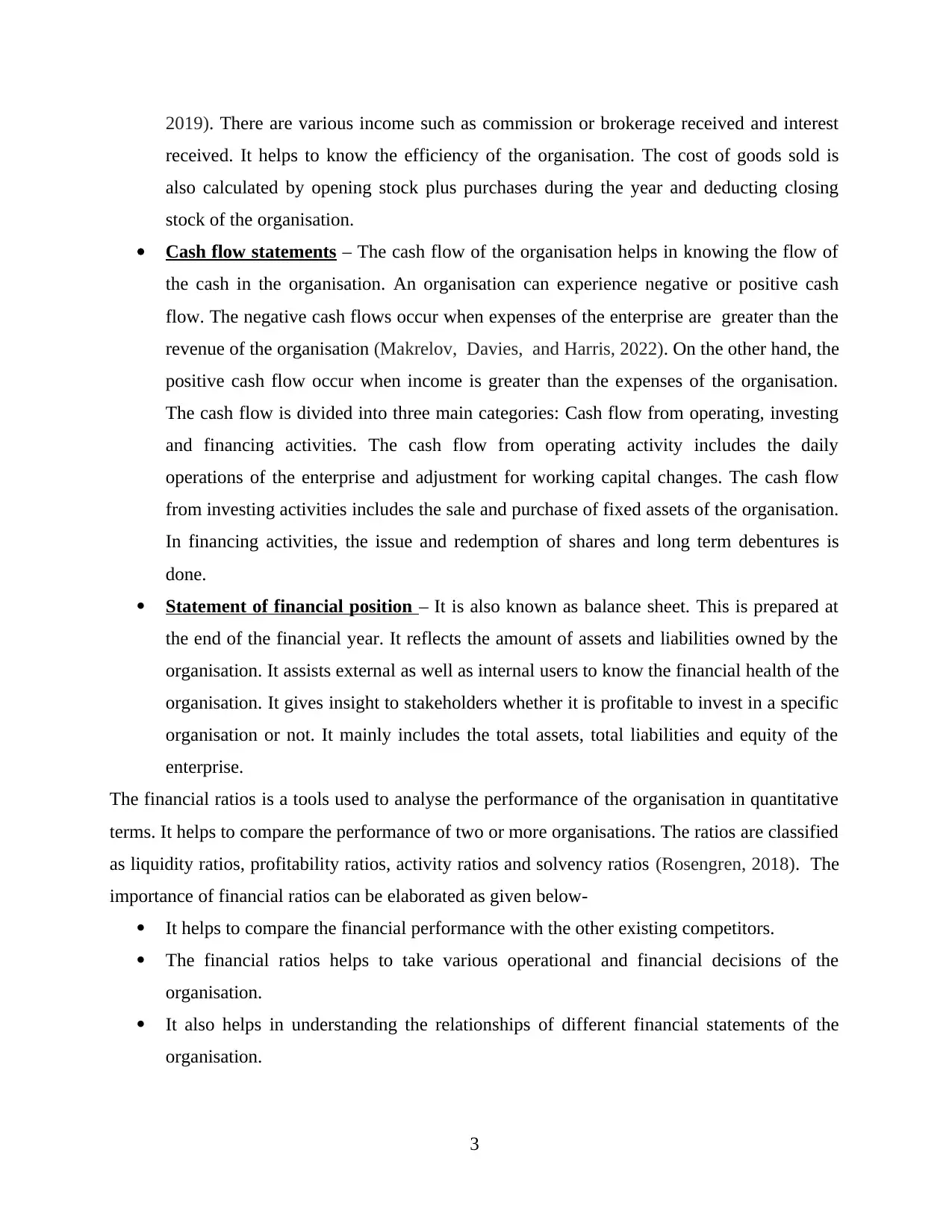
2019). There are various income such as commission or brokerage received and interest
received. It helps to know the efficiency of the organisation. The cost of goods sold is
also calculated by opening stock plus purchases during the year and deducting closing
stock of the organisation.
Cash flow statements – The cash flow of the organisation helps in knowing the flow of
the cash in the organisation. An organisation can experience negative or positive cash
flow. The negative cash flows occur when expenses of the enterprise are greater than the
revenue of the organisation (Makrelov, Davies, and Harris, 2022). On the other hand, the
positive cash flow occur when income is greater than the expenses of the organisation.
The cash flow is divided into three main categories: Cash flow from operating, investing
and financing activities. The cash flow from operating activity includes the daily
operations of the enterprise and adjustment for working capital changes. The cash flow
from investing activities includes the sale and purchase of fixed assets of the organisation.
In financing activities, the issue and redemption of shares and long term debentures is
done.
Statement of financial position – It is also known as balance sheet. This is prepared at
the end of the financial year. It reflects the amount of assets and liabilities owned by the
organisation. It assists external as well as internal users to know the financial health of the
organisation. It gives insight to stakeholders whether it is profitable to invest in a specific
organisation or not. It mainly includes the total assets, total liabilities and equity of the
enterprise.
The financial ratios is a tools used to analyse the performance of the organisation in quantitative
terms. It helps to compare the performance of two or more organisations. The ratios are classified
as liquidity ratios, profitability ratios, activity ratios and solvency ratios (Rosengren, 2018). The
importance of financial ratios can be elaborated as given below-
It helps to compare the financial performance with the other existing competitors.
The financial ratios helps to take various operational and financial decisions of the
organisation.
It also helps in understanding the relationships of different financial statements of the
organisation.
3
received. It helps to know the efficiency of the organisation. The cost of goods sold is
also calculated by opening stock plus purchases during the year and deducting closing
stock of the organisation.
Cash flow statements – The cash flow of the organisation helps in knowing the flow of
the cash in the organisation. An organisation can experience negative or positive cash
flow. The negative cash flows occur when expenses of the enterprise are greater than the
revenue of the organisation (Makrelov, Davies, and Harris, 2022). On the other hand, the
positive cash flow occur when income is greater than the expenses of the organisation.
The cash flow is divided into three main categories: Cash flow from operating, investing
and financing activities. The cash flow from operating activity includes the daily
operations of the enterprise and adjustment for working capital changes. The cash flow
from investing activities includes the sale and purchase of fixed assets of the organisation.
In financing activities, the issue and redemption of shares and long term debentures is
done.
Statement of financial position – It is also known as balance sheet. This is prepared at
the end of the financial year. It reflects the amount of assets and liabilities owned by the
organisation. It assists external as well as internal users to know the financial health of the
organisation. It gives insight to stakeholders whether it is profitable to invest in a specific
organisation or not. It mainly includes the total assets, total liabilities and equity of the
enterprise.
The financial ratios is a tools used to analyse the performance of the organisation in quantitative
terms. It helps to compare the performance of two or more organisations. The ratios are classified
as liquidity ratios, profitability ratios, activity ratios and solvency ratios (Rosengren, 2018). The
importance of financial ratios can be elaborated as given below-
It helps to compare the financial performance with the other existing competitors.
The financial ratios helps to take various operational and financial decisions of the
organisation.
It also helps in understanding the relationships of different financial statements of the
organisation.
3
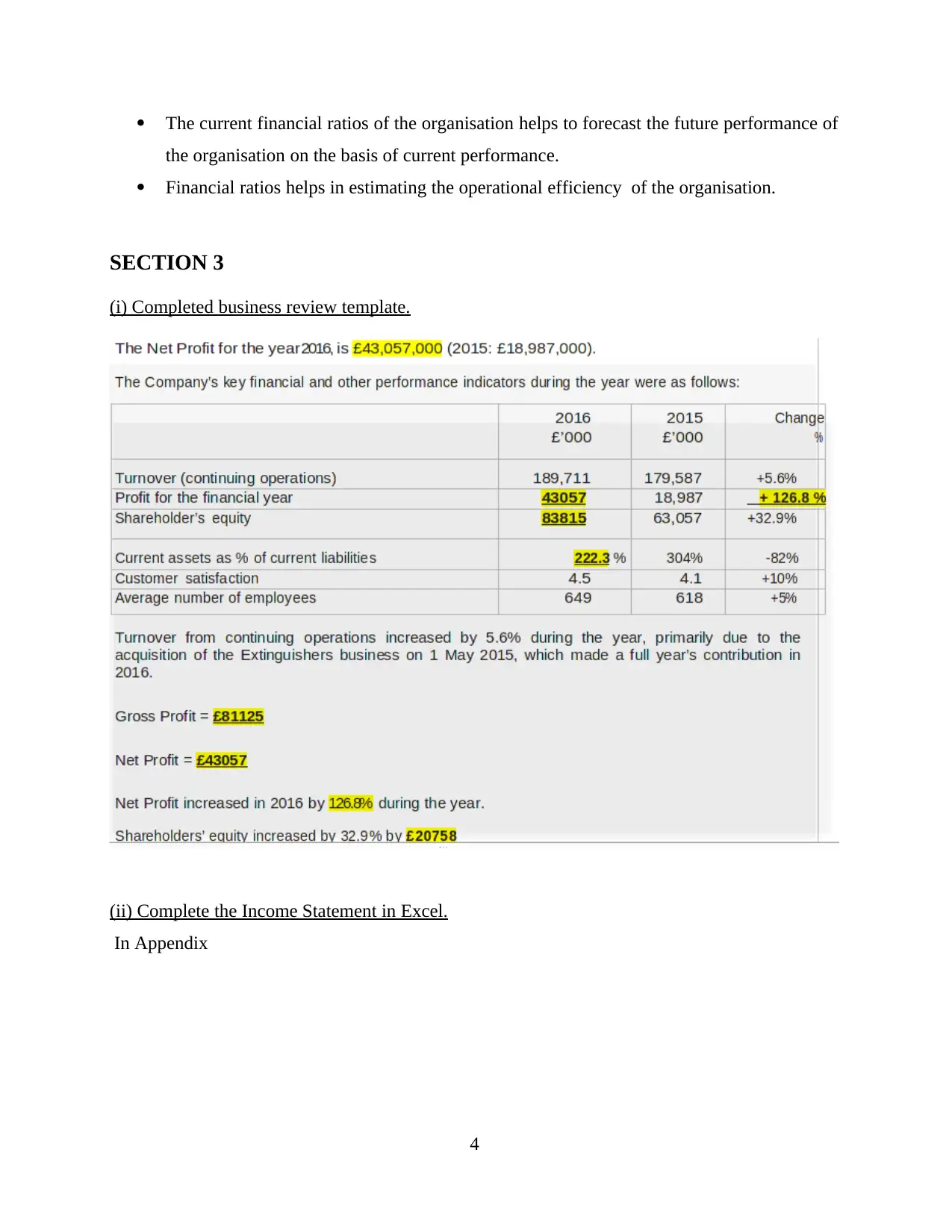
The current financial ratios of the organisation helps to forecast the future performance of
the organisation on the basis of current performance.
Financial ratios helps in estimating the operational efficiency of the organisation.
SECTION 3
(i) Completed business review template.
(ii) Complete the Income Statement in Excel.
In Appendix
4
the organisation on the basis of current performance.
Financial ratios helps in estimating the operational efficiency of the organisation.
SECTION 3
(i) Completed business review template.
(ii) Complete the Income Statement in Excel.
In Appendix
4
⊘ This is a preview!⊘
Do you want full access?
Subscribe today to unlock all pages.

Trusted by 1+ million students worldwide
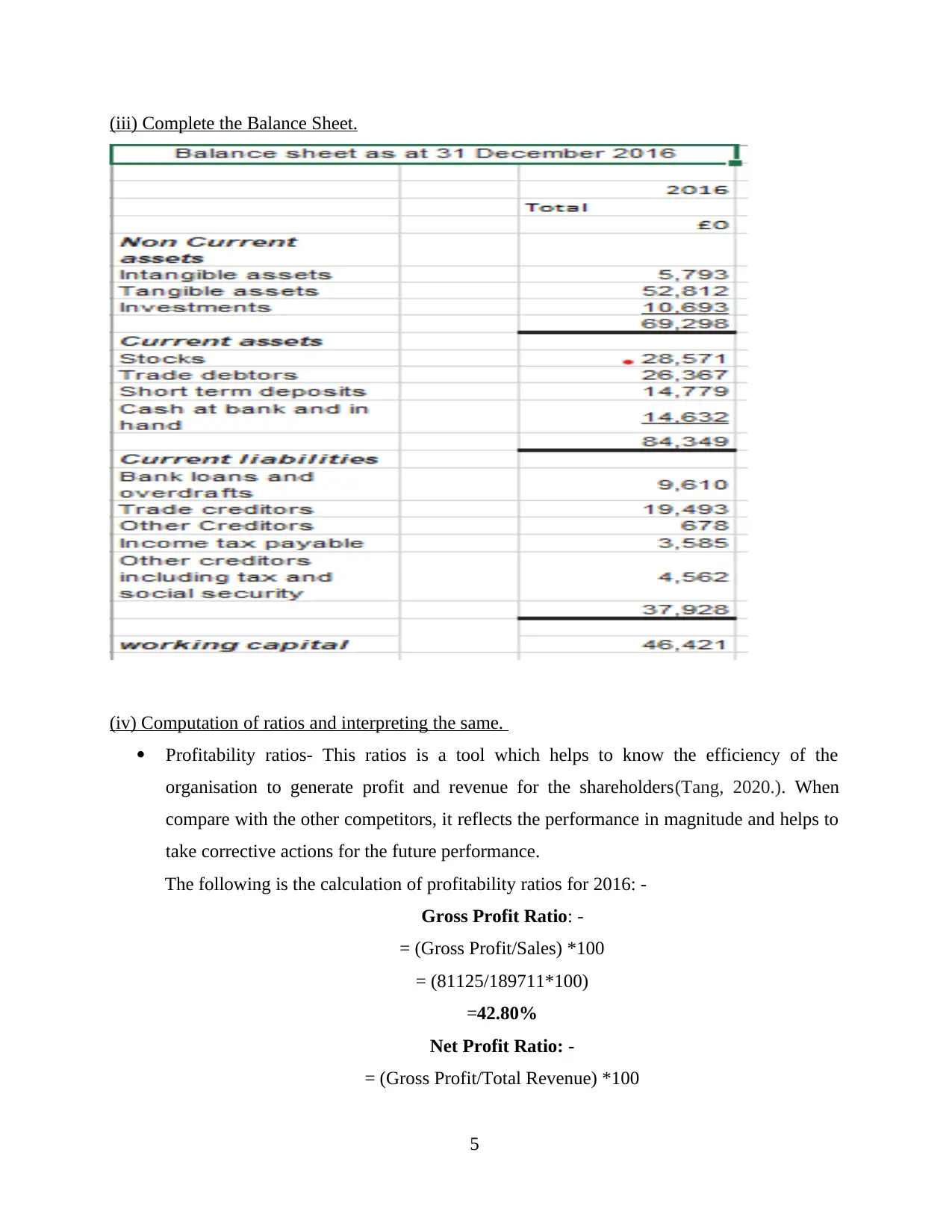
(iii) Complete the Balance Sheet.
(iv) Computation of ratios and interpreting the same.
Profitability ratios- This ratios is a tool which helps to know the efficiency of the
organisation to generate profit and revenue for the shareholders(Tang, 2020.). When
compare with the other competitors, it reflects the performance in magnitude and helps to
take corrective actions for the future performance.
The following is the calculation of profitability ratios for 2016: -
Gross Profit Ratio: -
= (Gross Profit/Sales) *100
= (81125/189711*100)
=42.80%
Net Profit Ratio: -
= (Gross Profit/Total Revenue) *100
5
(iv) Computation of ratios and interpreting the same.
Profitability ratios- This ratios is a tool which helps to know the efficiency of the
organisation to generate profit and revenue for the shareholders(Tang, 2020.). When
compare with the other competitors, it reflects the performance in magnitude and helps to
take corrective actions for the future performance.
The following is the calculation of profitability ratios for 2016: -
Gross Profit Ratio: -
= (Gross Profit/Sales) *100
= (81125/189711*100)
=42.80%
Net Profit Ratio: -
= (Gross Profit/Total Revenue) *100
5
Paraphrase This Document
Need a fresh take? Get an instant paraphrase of this document with our AI Paraphraser
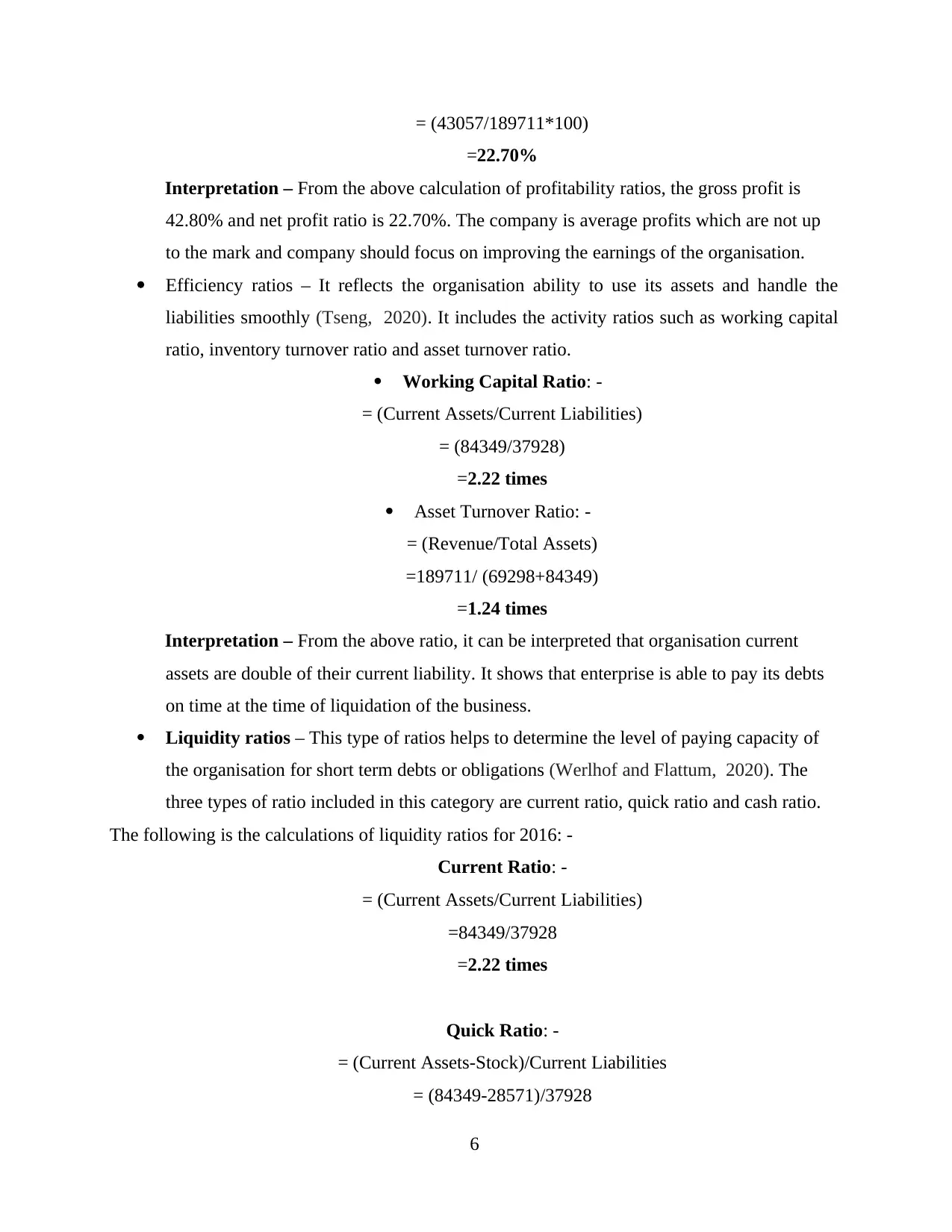
= (43057/189711*100)
=22.70%
Interpretation – From the above calculation of profitability ratios, the gross profit is
42.80% and net profit ratio is 22.70%. The company is average profits which are not up
to the mark and company should focus on improving the earnings of the organisation.
Efficiency ratios – It reflects the organisation ability to use its assets and handle the
liabilities smoothly (Tseng, 2020). It includes the activity ratios such as working capital
ratio, inventory turnover ratio and asset turnover ratio.
Working Capital Ratio: -
= (Current Assets/Current Liabilities)
= (84349/37928)
=2.22 times
Asset Turnover Ratio: -
= (Revenue/Total Assets)
=189711/ (69298+84349)
=1.24 times
Interpretation – From the above ratio, it can be interpreted that organisation current
assets are double of their current liability. It shows that enterprise is able to pay its debts
on time at the time of liquidation of the business.
Liquidity ratios – This type of ratios helps to determine the level of paying capacity of
the organisation for short term debts or obligations (Werlhof and Flattum, 2020). The
three types of ratio included in this category are current ratio, quick ratio and cash ratio.
The following is the calculations of liquidity ratios for 2016: -
Current Ratio: -
= (Current Assets/Current Liabilities)
=84349/37928
=2.22 times
Quick Ratio: -
= (Current Assets-Stock)/Current Liabilities
= (84349-28571)/37928
6
=22.70%
Interpretation – From the above calculation of profitability ratios, the gross profit is
42.80% and net profit ratio is 22.70%. The company is average profits which are not up
to the mark and company should focus on improving the earnings of the organisation.
Efficiency ratios – It reflects the organisation ability to use its assets and handle the
liabilities smoothly (Tseng, 2020). It includes the activity ratios such as working capital
ratio, inventory turnover ratio and asset turnover ratio.
Working Capital Ratio: -
= (Current Assets/Current Liabilities)
= (84349/37928)
=2.22 times
Asset Turnover Ratio: -
= (Revenue/Total Assets)
=189711/ (69298+84349)
=1.24 times
Interpretation – From the above ratio, it can be interpreted that organisation current
assets are double of their current liability. It shows that enterprise is able to pay its debts
on time at the time of liquidation of the business.
Liquidity ratios – This type of ratios helps to determine the level of paying capacity of
the organisation for short term debts or obligations (Werlhof and Flattum, 2020). The
three types of ratio included in this category are current ratio, quick ratio and cash ratio.
The following is the calculations of liquidity ratios for 2016: -
Current Ratio: -
= (Current Assets/Current Liabilities)
=84349/37928
=2.22 times
Quick Ratio: -
= (Current Assets-Stock)/Current Liabilities
= (84349-28571)/37928
6
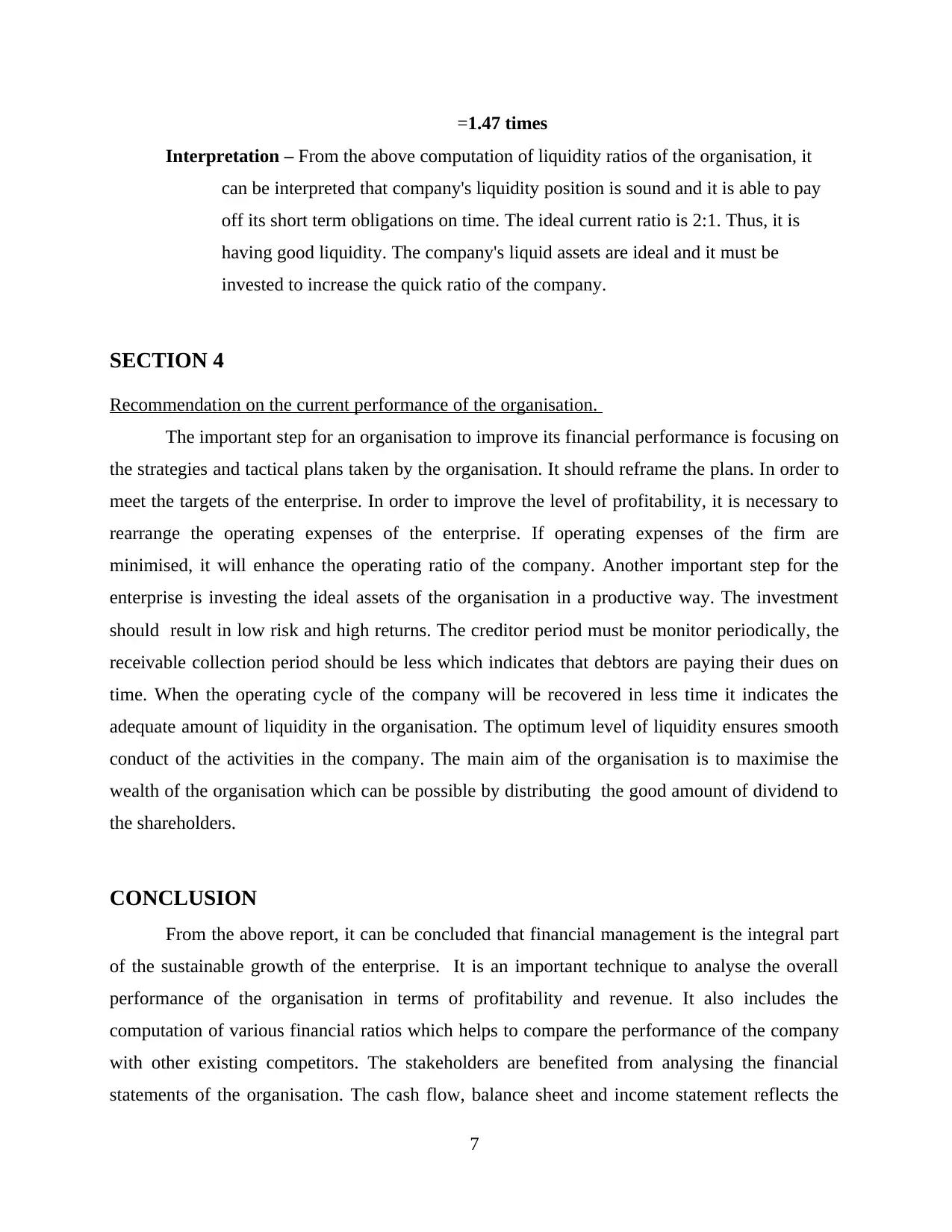
=1.47 times
Interpretation – From the above computation of liquidity ratios of the organisation, it
can be interpreted that company's liquidity position is sound and it is able to pay
off its short term obligations on time. The ideal current ratio is 2:1. Thus, it is
having good liquidity. The company's liquid assets are ideal and it must be
invested to increase the quick ratio of the company.
SECTION 4
Recommendation on the current performance of the organisation.
The important step for an organisation to improve its financial performance is focusing on
the strategies and tactical plans taken by the organisation. It should reframe the plans. In order to
meet the targets of the enterprise. In order to improve the level of profitability, it is necessary to
rearrange the operating expenses of the enterprise. If operating expenses of the firm are
minimised, it will enhance the operating ratio of the company. Another important step for the
enterprise is investing the ideal assets of the organisation in a productive way. The investment
should result in low risk and high returns. The creditor period must be monitor periodically, the
receivable collection period should be less which indicates that debtors are paying their dues on
time. When the operating cycle of the company will be recovered in less time it indicates the
adequate amount of liquidity in the organisation. The optimum level of liquidity ensures smooth
conduct of the activities in the company. The main aim of the organisation is to maximise the
wealth of the organisation which can be possible by distributing the good amount of dividend to
the shareholders.
CONCLUSION
From the above report, it can be concluded that financial management is the integral part
of the sustainable growth of the enterprise. It is an important technique to analyse the overall
performance of the organisation in terms of profitability and revenue. It also includes the
computation of various financial ratios which helps to compare the performance of the company
with other existing competitors. The stakeholders are benefited from analysing the financial
statements of the organisation. The cash flow, balance sheet and income statement reflects the
7
Interpretation – From the above computation of liquidity ratios of the organisation, it
can be interpreted that company's liquidity position is sound and it is able to pay
off its short term obligations on time. The ideal current ratio is 2:1. Thus, it is
having good liquidity. The company's liquid assets are ideal and it must be
invested to increase the quick ratio of the company.
SECTION 4
Recommendation on the current performance of the organisation.
The important step for an organisation to improve its financial performance is focusing on
the strategies and tactical plans taken by the organisation. It should reframe the plans. In order to
meet the targets of the enterprise. In order to improve the level of profitability, it is necessary to
rearrange the operating expenses of the enterprise. If operating expenses of the firm are
minimised, it will enhance the operating ratio of the company. Another important step for the
enterprise is investing the ideal assets of the organisation in a productive way. The investment
should result in low risk and high returns. The creditor period must be monitor periodically, the
receivable collection period should be less which indicates that debtors are paying their dues on
time. When the operating cycle of the company will be recovered in less time it indicates the
adequate amount of liquidity in the organisation. The optimum level of liquidity ensures smooth
conduct of the activities in the company. The main aim of the organisation is to maximise the
wealth of the organisation which can be possible by distributing the good amount of dividend to
the shareholders.
CONCLUSION
From the above report, it can be concluded that financial management is the integral part
of the sustainable growth of the enterprise. It is an important technique to analyse the overall
performance of the organisation in terms of profitability and revenue. It also includes the
computation of various financial ratios which helps to compare the performance of the company
with other existing competitors. The stakeholders are benefited from analysing the financial
statements of the organisation. The cash flow, balance sheet and income statement reflects the
7
⊘ This is a preview!⊘
Do you want full access?
Subscribe today to unlock all pages.

Trusted by 1+ million students worldwide

different financial aspects of the organisation. It also include the recommendation to the
organisation through which financial performance of the organisation can be improved.
8
organisation through which financial performance of the organisation can be improved.
8
Paraphrase This Document
Need a fresh take? Get an instant paraphrase of this document with our AI Paraphraser

REFERENCES
Books and Journals
Belfort, A., Scherzl, N. and Broussin, J., 2018. Guadeloupe key energy figures-2017 statement.
Guadeloupe energy balance sheet 2017. Energy insecurity in Guadeloupe, a socio-
anthropological approach for a definition of energy insecurity in tropical environment.
Detzel, A., Schaberl, P. and Strauss, J., 2019. Expected versus Ex Post Profitability in the Cross‐
Section of Industry Returns. Financial Management, 48(2), pp.505-536.
Erin, O and et.al., 2018. Does international financial reporting standards (IFRS) impact
profitability ratios of listed banks in Nigeria. Journal of accounting, business and
finance research, 2(2), pp.79-90.
Jain, P.K., McInish, T.H. and Miller, J.L., 2019. Insights from bitcoin trading. Financial
Management, 48(4), pp.1031-1048.
Makrelov, K., Davies, R. and Harris, L., 2022. The impact of higher leverage ratios on the South
African economy. Studies in Economics and Econometrics, pp.1-24.
Rosengren, E.S., 2018. Comments on “A skeptical view of the impact of the Fed’s balance
sheet”: remarks delivered at the 2018 US Monetary Policy Forum, New York, New
York, February 23, 2018 (No. 127).
Tang, Y., 2020. Financial risk and early warning based on Qingdao marine economic
forecast. Journal of Coastal Research, 112(SI), pp.195-198.
Tseng, Y.C., 2020. The Relationship between Cash Flow Volatility and the Adjustment Speed of
Accounts Receivable.
Werlhof, J. and Flattum, J., 2020. Improving cash flow with loss carrybacks. The Tax
Adviser, 51(12), pp.810-815.
9
Books and Journals
Belfort, A., Scherzl, N. and Broussin, J., 2018. Guadeloupe key energy figures-2017 statement.
Guadeloupe energy balance sheet 2017. Energy insecurity in Guadeloupe, a socio-
anthropological approach for a definition of energy insecurity in tropical environment.
Detzel, A., Schaberl, P. and Strauss, J., 2019. Expected versus Ex Post Profitability in the Cross‐
Section of Industry Returns. Financial Management, 48(2), pp.505-536.
Erin, O and et.al., 2018. Does international financial reporting standards (IFRS) impact
profitability ratios of listed banks in Nigeria. Journal of accounting, business and
finance research, 2(2), pp.79-90.
Jain, P.K., McInish, T.H. and Miller, J.L., 2019. Insights from bitcoin trading. Financial
Management, 48(4), pp.1031-1048.
Makrelov, K., Davies, R. and Harris, L., 2022. The impact of higher leverage ratios on the South
African economy. Studies in Economics and Econometrics, pp.1-24.
Rosengren, E.S., 2018. Comments on “A skeptical view of the impact of the Fed’s balance
sheet”: remarks delivered at the 2018 US Monetary Policy Forum, New York, New
York, February 23, 2018 (No. 127).
Tang, Y., 2020. Financial risk and early warning based on Qingdao marine economic
forecast. Journal of Coastal Research, 112(SI), pp.195-198.
Tseng, Y.C., 2020. The Relationship between Cash Flow Volatility and the Adjustment Speed of
Accounts Receivable.
Werlhof, J. and Flattum, J., 2020. Improving cash flow with loss carrybacks. The Tax
Adviser, 51(12), pp.810-815.
9
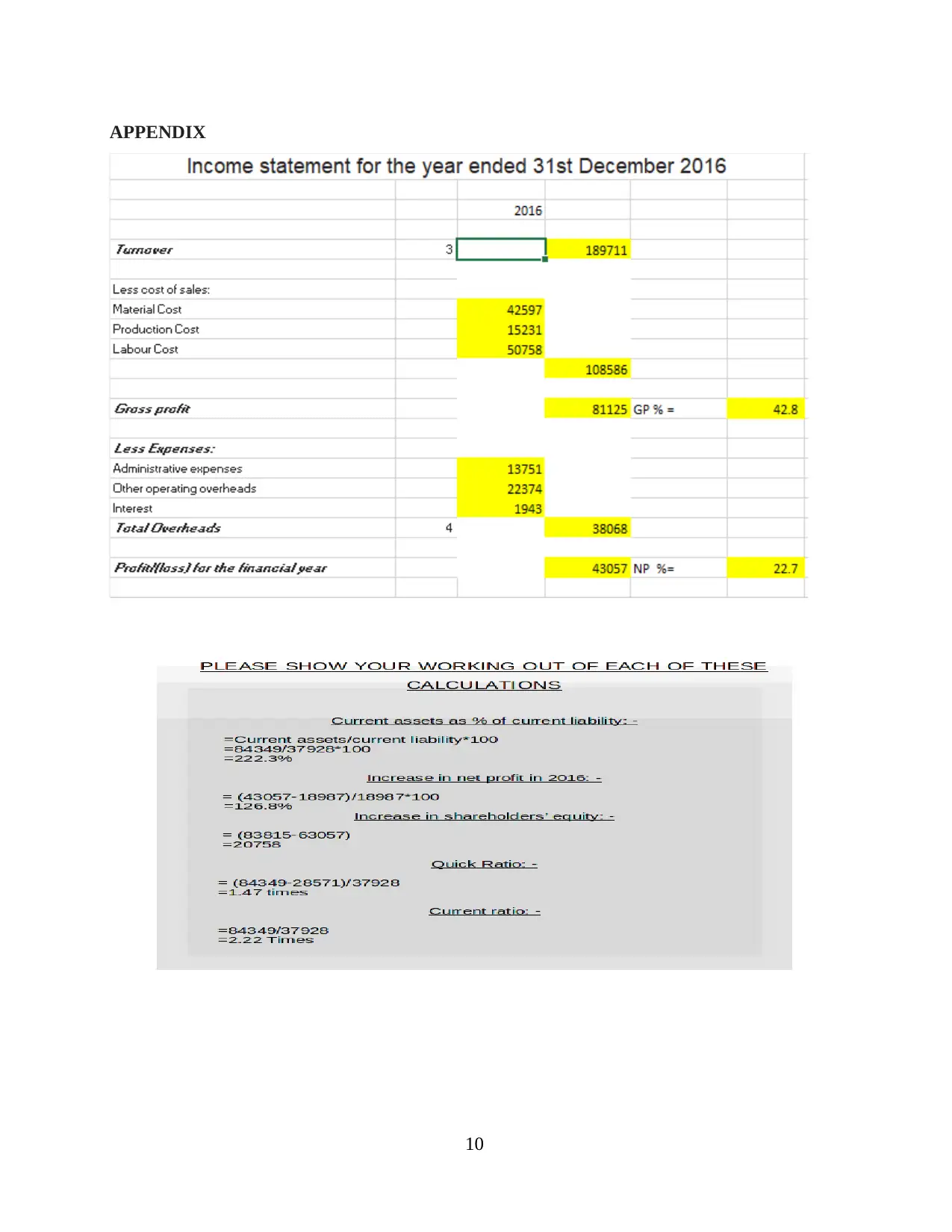
APPENDIX
10
10
⊘ This is a preview!⊘
Do you want full access?
Subscribe today to unlock all pages.

Trusted by 1+ million students worldwide
1 out of 12
Related Documents
Your All-in-One AI-Powered Toolkit for Academic Success.
+13062052269
info@desklib.com
Available 24*7 on WhatsApp / Email
![[object Object]](/_next/static/media/star-bottom.7253800d.svg)
Unlock your academic potential
Copyright © 2020–2025 A2Z Services. All Rights Reserved. Developed and managed by ZUCOL.



